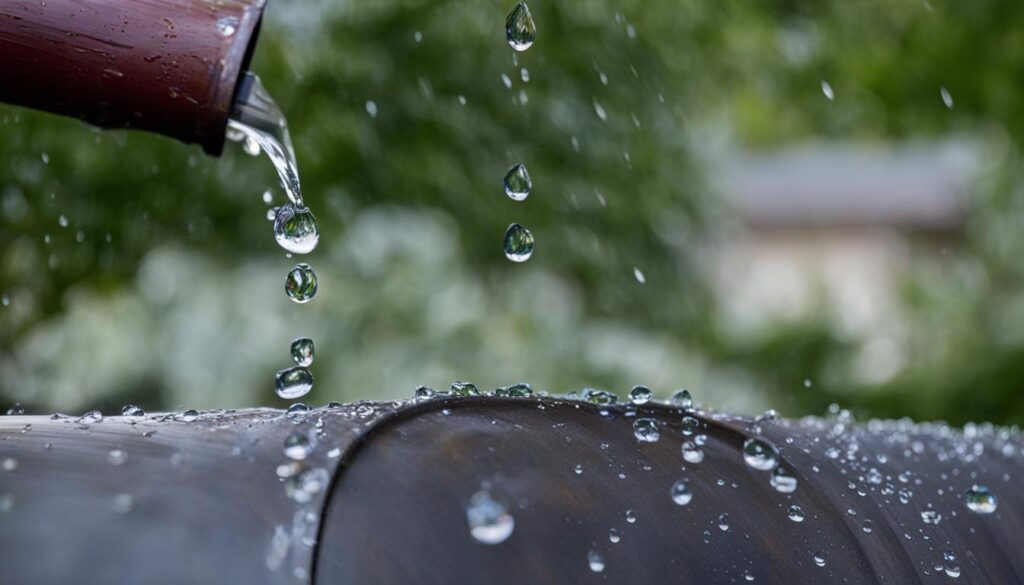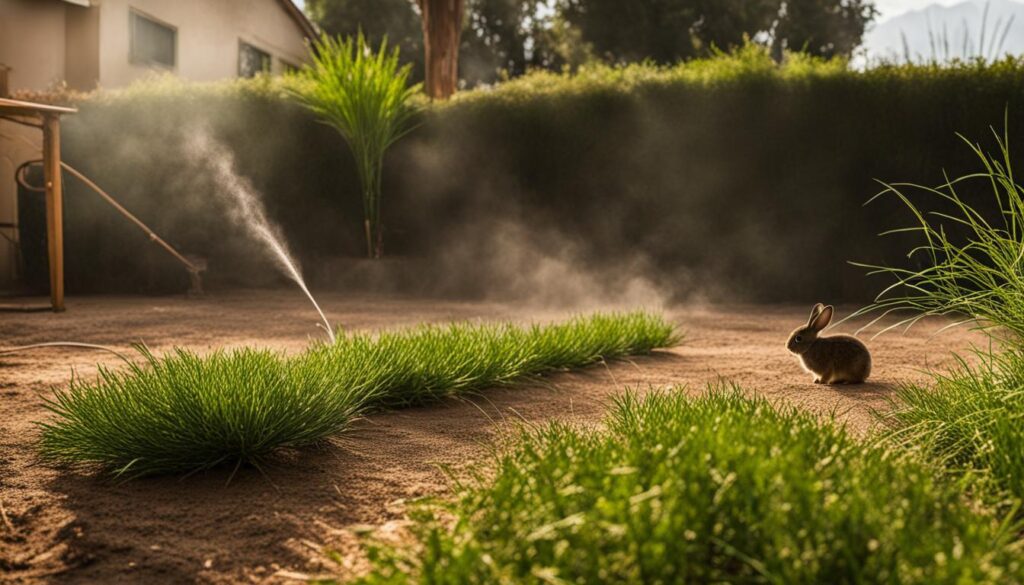When faced with hot and dry weather during a drought, it is important to water your garden wisely to conserve water and maintain a beautiful landscape. Xeriscaping, or drought-tolerant gardening, is a smart and sustainable approach that allows your plants to thrive with minimal water. In this article, we will explore 12 essential tips for maintaining a xeriscape garden in drought, ensuring that your garden remains vibrant and healthy even in the toughest conditions.
Key Takeaways:
- Understanding the water needs of your plants is crucial for maintaining a xeriscape garden in drought.
- Watering wisely includes timing your watering, using soaker hoses, and watering deeply but less frequently.
- Conservation practices like rainwater harvesting, choosing drought-tolerant plants, and mulching help conserve water in xeriscaping.
- Strategies for maintaining a drought-tolerant lawn involve watering deeply and infrequently, mowing minimally, and avoiding over-fertilization.
- Embracing xeriscape gardening practices contributes to water conservation efforts and helps you maintain a beautiful garden even in dry conditions.
Understanding the Water Needs of Your Plants
When it comes to maintaining a xeriscape garden during a drought, understanding the water requirements of your plants is crucial. Each type of plant has its specific water needs, and providing the right amount of water will help them thrive with minimal water usage. The general rule of thumb is that plants require about an inch of water per week, but it’s important to consider other factors such as the type of soil and the weather conditions in your area.
To ensure you’re watering your plants efficiently, it’s essential to spread that inch of water over a 10×10 foot space, which can equal 62 gallons. This can be a significant amount, especially if you have a large garden or restricted access to water. Avoid both over-watering and under-watering your plants by finding ways to make the most out of the water you have.
One effective strategy is to group plants with similar water needs together. This way, you can provide targeted watering based on the requirements of each group. Additionally, incorporating drought-tolerant plants into your garden can greatly reduce water consumption. These plants are adapted to survive in dry conditions and require less water compared to more water-dependent species. By understanding the water needs of your plants and implementing smart watering practices, you can maintain a beautiful xeriscape garden while conserving water.
Watering Wisely in Dry Weather
When it comes to maintaining a xeriscape garden during a drought, watering wisely is crucial. By following smart watering tips, you can ensure that your plants receive the necessary moisture while conserving water. Here are some key techniques to keep in mind:
1. Time it right:
The best time to water your garden is in the morning between 4 AM and 9 AM. Watering during these cooler hours minimizes evaporation and allows the moisture to penetrate the soil effectively. Avoid watering in the afternoon when the heat is at its peak, as this can result in water loss due to evaporation.
2. Water at the base:
Instead of watering from above, it is best to water at the base of the plants. This helps keep the foliage dry, reducing the risk of disease. Use a soaker hose or drip irrigation system to deliver water directly to the roots. These methods ensure that 90% of the water goes where it’s needed and minimizes weed growth.
3. Water deeply, but less frequently:
When watering, aim to provide a deep soak to promote healthy root growth. Watering deeply encourages the roots to grow deeper into the soil, making the plants more resilient to drought conditions. However, it’s important to water less frequently to avoid waterlogging the roots. Let the topsoil dry out before watering again, usually about 1-2 inches deep.
By implementing these smart watering techniques, you can effectively maintain your xeriscape garden in dry weather. Remember to adapt your watering schedule based on the specific needs of your plants and the local climate. With proper care, your garden will thrive while conserving water resources.
Conservation Practices in Xeriscaping
Xeriscaping is a sustainable landscaping practice that focuses on reducing water usage. Implementing conservation practices in xeriscaping not only helps to preserve water resources but also promotes the growth of drought-tolerant plants. Here are some effective conservation practices to incorporate into your xeriscape garden:
Select Drought-Tolerant Plants
Choosing plants that are naturally adapted to arid climates is key to conserving water in xeriscaping. Opt for drought-tolerant plants that require minimal watering once established. These plants have the ability to thrive in dry conditions and can withstand prolonged periods of water scarcity. Some popular drought-tolerant plant options include succulents, ornamental grasses, and native wildflowers. By selecting these plants, you can significantly reduce the need for excessive watering and ensure the long-term sustainability of your garden.
Utilize Rainwater Harvesting
Rainwater harvesting is an effective method to supplement your garden’s water needs without relying heavily on municipal or well water. Install rain barrels or cisterns to collect rainwater from your rooftop, directing it into storage containers. This collected rainwater can then be used to water your xeriscape garden during dry periods. Not only does rainwater harvesting conserve water, but it also provides natural, unchlorinated water that is beneficial for the health of your plants.
Incorporate Mulching
Mulching plays a vital role in conserving moisture in xeriscape gardens. Apply a layer of organic mulch, such as wood chips or straw, around the base of your plants. Mulch acts as a barrier, preventing water evaporation from the soil and reducing weed growth. Additionally, it helps regulate soil temperature, keeping it cooler during hot weather. By incorporating mulching into your xeriscape garden, you can minimize water loss and promote healthier plant growth.
By implementing these conservation practices in your xeriscape garden, you can create a sustainable and water-efficient landscape. Selecting drought-tolerant plants, utilizing rainwater harvesting, and incorporating mulching techniques will help conserve water while maintaining the beauty of your garden.
How Can I Maintain My Xeriscape Garden During a Dry Spell?
During a dry spell, a xeriscape garden requires special care to thrive. To maintain your xeriscape garden, follow these yearround garden upkeep tips: mulch to retain moisture, hand water as needed, and prune to remove dead plant material. These practices will help your garden survive and flourish in dry conditions.
Strategies for Maintaining a Drought-Tolerant Lawn
Drought conditions can take a toll on your lawn, but with the right strategies, you can keep it healthy and green. Whether you choose to let your lawn go dormant or continue watering it, there are steps you can take to manage your lawn during dry spells. Here are some strategies for maintaining a drought-tolerant lawn:
Water Deeply and Infrequently
- When watering your lawn during a drought, it’s important to water deeply and infrequently. This encourages the roots to grow deeper in search of water, making your lawn more resilient to dry conditions.
- Watering deeply also helps prevent shallow root growth, which can leave your lawn vulnerable to drought stress.
- Instead of watering for short periods every day, water for longer periods less frequently. Aim for about an inch of water per week, applied in one or two sessions.
Be Mindful of Fertilizer
During a drought, it’s best to minimize fertilizer use as it can increase the water needs of your lawn. Excess fertilizer can stimulate fast growth, which requires more water to maintain.
Mow with Care
- When mowing your lawn during a drought, it’s important to mow with care to minimize stress on the grass.
- Set your mower blades to a higher setting to leave the grass longer. This helps shade the soil and reduces evaporation.
- Avoid cutting your lawn too short, as this can weaken the grass and make it more susceptible to drought damage.
By following these strategies, you can maintain a drought-tolerant lawn that stays green and healthy even in dry conditions. Remember to adjust your lawn care routine based on local water restrictions and guidelines to ensure responsible water usage.
Conclusion
Maintaining a drought-tolerant garden is not only possible, but it also allows you to conserve water and ensure the vitality of your plants. By following these tips for drought-tolerant gardening and maintaining a xeriscape garden, you can create a beautiful and sustainable landscape.
First and foremost, understanding the water needs of your plants is crucial. By providing them with the right amount of water, you can avoid both over-watering and under-watering. Remember that watering deeply but less frequently allows the water to reach the roots, promoting healthier plants.
In addition to watering wisely, conserving water through xeriscaping practices is key. Choose drought-tolerant plants, practice efficient irrigation methods, and consider rainwater harvesting. Collecting rainwater in barrels provides your plants with natural, unchlorinated water while reducing your reliance on other water sources.
Lastly, when it comes to managing lawns in dry conditions, allowing the grass to go dormant is a smart choice. However, if you decide to water your lawn, do so deeply and infrequently. Keep the grass longer to provide shade and reduce evaporation. Minimize mowing to help your lawn conserve moisture.
By embracing these tips for drought-tolerant gardening and maintaining a xeriscape garden, you can play a role in water conservation efforts while still enjoying a thriving and beautiful landscape.












